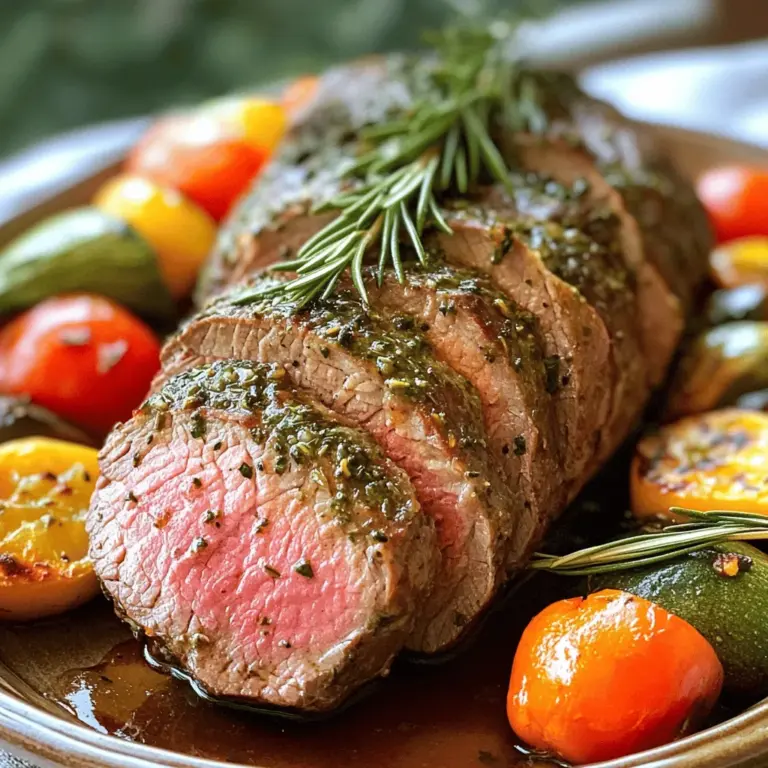Are you ready to impress your guests with a mouthwatering Herb Butter Beef Tenderloin Roast? This tender cut of beef, slathered in rich herb-infused butter, transforms dinner into a feast. I’ll guide you through each step, from selecting the perfect meat to achieving a deliciously golden crust. Get ready to elevate your cooking with simple tips and tricks that ensure each bite is bursting with flavor. Let’s dive in!
Ingredients
Main Ingredients
- Beef tenderloin
- Unsalted butter
- Fresh herbs (rosemary, thyme, parsley)
- Garlic
The star of this dish is the beef tenderloin. It is tender and has rich flavor. I prefer using a 2 to 3-pound cut. This size is perfect for a family meal or a small gathering. Next, I use unsalted butter to make the herb butter. It allows me to control the salt level in my dish. The fresh herbs add a burst of flavor. I love using rosemary, thyme, and parsley for their aromatic qualities. Garlic is a must. It gives the beef a wonderful depth of flavor.
Optional Flavors
- Dijon mustard
- Olive oil
- Beef broth
Sometimes, I like to add Dijon mustard to the herb butter. It adds a nice tang that balances the richness of the beef. Olive oil helps in seasoning the tenderloin. I use it to coat the meat before applying the herb butter. Beef broth is great for making a rich sauce. It enhances the flavor when I baste the tenderloin during cooking.
Seasoning Requirements
- Salt and pepper to taste
- Tips for selecting the right beef cut
Seasoning is crucial for this dish. I always use salt and pepper to bring out the flavor. When selecting beef, look for a cut with good marbling. This means there are thin streaks of fat. Marbling keeps the meat juicy and adds flavor. Always ask your butcher for advice if you are unsure. They’ll help you choose the best cut for your roast.
Step-by-Step Instructions
Prepping the Oven and Ingredients
- Preheat your oven to 425°F (220°C).
- In a medium bowl, mix together:
- 1/2 cup unsalted butter, softened
- 4 cloves garlic, minced
- 2 tablespoons fresh rosemary, finely chopped
- 2 tablespoons fresh thyme, finely chopped
- 1 tablespoon fresh parsley, finely chopped
- 1 tablespoon Dijon mustard
- Salt and pepper to taste
Mix until the herbs and garlic blend well with the butter. This herb butter adds rich flavor to the tenderloin.
Tenderloin Preparation
- Pat the beef tenderloin dry with paper towels.
- Rub 1 tablespoon of olive oil over the tenderloin.
- Generously season it with salt and pepper.
- Spread half of the herb butter mixture evenly over the tenderloin. Reserve the remaining butter for basting later.
Drying the meat helps it brown better. The herb butter will create a delicious crust.
Cooking Techniques
- In a large oven-safe skillet, heat a little olive oil over medium-high heat.
- Once hot, add the tenderloin and sear it on all sides. Aim for a golden brown crust, about 3-4 minutes per side.
- Transfer the skillet to the preheated oven. Roast the tenderloin for 25-30 minutes. Use a meat thermometer to check for doneness:
- 135°F for medium-rare
- 145°F for medium
- Every 10 minutes, baste the tenderloin with the reserved herb butter. This keeps it moist and boosts flavor.
This method ensures a tender, juicy roast. The basting step is key to enhancing that rich taste.
Tips & Tricks
Basting Techniques
Basting with herb butter adds rich flavor. It keeps the meat juicy and tender. During roasting, I baste every 10 minutes. Each time, I take the skillet out and spoon butter over the top. This method ensures the tenderloin absorbs all those tasty herb notes.
Resting and Slicing
Letting the meat rest is vital. I always allow it to sit for 10 minutes after cooking. This step helps the juices settle back in, making each slice moist. For slicing, I use a sharp knife. I cut the tenderloin into medallions, about an inch thick. This size looks nice on plates and stays juicy.
Presentation Suggestions
Arranging the slices on a warm platter makes a great visual. I like to fan them out for a nice look. For a finishing touch, I garnish with fresh rosemary sprigs. Pair the roast with seasonal veggies or mashed potatoes to complete the dish. These simple additions make it even more inviting.

Variations
Herb Alternatives
You can switch herbs to change the flavor. Try using sage or dill for a unique twist. You can also mix herbs for a complex taste. Pairing herbs with spices like smoked paprika or cumin can add depth. Experiment with what you have on hand to find your favorite blend.
Cooking Method Variations
You can cook this beef tenderloin in different ways. For a slow cooker, season the tenderloin and place it in the cooker with the herb butter. Add beef broth and cook on low for 6-8 hours. This method makes the meat very tender and juicy.
If you prefer grilling, you can do that, too! Preheat your grill to medium-high heat. Sear the tenderloin on all sides, then move it to a cooler part of the grill. Cook until it reaches your desired doneness.
Serving Suggestions
This tenderloin pairs well with many side dishes. Roasted vegetables or creamy mashed potatoes are great choices. You can also serve it with a fresh salad for a lighter meal.
When it comes to wine, a full-bodied red wine works best. Cabernet Sauvignon or Merlot enhances the beef flavor nicely. Consider serving a nice red wine to elevate your meal.
Storage Info
Leftover Storage Tips
To store your leftovers safely, let the beef cool first. Place the beef in an airtight container. This keeps moisture in and prevents odors from mixing. You can store it in the refrigerator for up to three days. For longer storage, wrap the beef tightly in plastic wrap or aluminum foil, then place it in the freezer. This method helps avoid freezer burn.
Reheating Instructions
When reheating, keep the beef tender and juicy. The best way is to use the oven. Preheat your oven to 250°F (120°C). Place the beef on a baking sheet and cover it with foil. Heat it for about 20-25 minutes. This keeps the meat moist and brings back its flavors. If you’re in a rush, you can use a microwave. However, be careful not to overcook it. Heat in short bursts, checking frequently.
Shelf Life
In the fridge, your leftover beef tenderloin will last for about three days. If you freeze it, you can keep it for up to three months. After that, the quality may drop, though it will still be safe to eat. Always check for any off smells or changes in color before consuming.
FAQs
How do I know when the beef tenderloin is cooked?
The best way to check if your beef tenderloin is cooked is by using a meat thermometer. For medium-rare, aim for an internal temperature of 135°F. For medium, look for 145°F. Insert the thermometer into the thickest part of the meat. This ensures you get an accurate reading. Let the meat rest after cooking. This helps juices stay inside the meat.
Can I make the herb butter ahead of time?
Yes, you can prepare the herb butter in advance. Mix all the ingredients and store it in the fridge. Wrap it tightly in plastic wrap or place it in an airtight container. It can last up to a week in the refrigerator. If you want to keep it longer, freeze it. Herb butter can be frozen for up to three months. Just slice off what you need when you’re ready to use it.
What is the best cut of beef for tenderloin?
When choosing beef tenderloin, look for a cut that has a nice, even shape. The meat should be bright red with minimal fat. You want a tender piece that will cook evenly. Also, consider the grade of the meat. Prime grade has the most marbling and flavor. Choice grade is good for a delicious roast but may not be as tender. When you buy, ask your butcher for advice too.
How can I increase the flavor of my roast?
To boost the flavor of your roast, use fresh herbs like rosemary and thyme. Rub the tenderloin with olive oil and season it well with salt and pepper. Basting the meat with herb butter while it cooks also adds flavor. You can even add garlic or shallots to the pan for extra taste. Don’t forget to let the meat rest before slicing. This keeps it juicy and flavorful.
In this post, we explored how to make a perfect beef tenderloin. We covered main ingredients, optional flavors, and seasoning tips. I shared step-by-step cooking instructions and essential tips for basting and resting. You learned about variations in herbs and cooking methods, plus serving and storage tips.
Remember, a well-cooked tenderloin can impress anyone at your table. Keep practicing, and your meals will shine. Enjoy your cooking journey!
- Herb Butter Beef Tenderloin Roast

